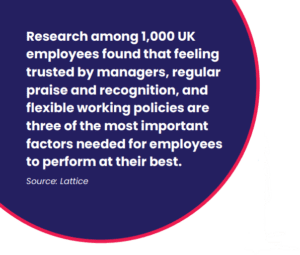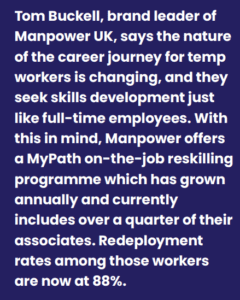To get the most from contractors, organisations should offer similar recognition and perks as FTEs.
By Simon Kent
 There is no doubt that an agile workforce is something that every organisation craves, especially during times of economic uncertainty. However, whilst the ability to have a flexible supply of workers is one thing, inspiring and motivating those contractors to ensure they hit their goals is another.
There is no doubt that an agile workforce is something that every organisation craves, especially during times of economic uncertainty. However, whilst the ability to have a flexible supply of workers is one thing, inspiring and motivating those contractors to ensure they hit their goals is another.
“Irrespective of whether they’re permanent, on contract, or temps, good staff is a precious resource and smart employers will go out of their way to ensure they keep coming back,” says Novo Constare, CEO and co-founder of Indeed Flex, an online staffing platform for temporary work. “Making temporary workers feel part of the company begins right from the outset, with someone welcoming them to the premises and providing a thorough introduction with an outline of how the day will be structured, including any lunch breaks, providing directions to the toilets and cloakroom, and giving health and safety instructions.”
Certainly, Leigh Passingham, Brook Street brand leader and UK board director, advocates a proactive approach for getting the best from temporary staff as soon as—or even before—they walk through the door. “To drive engagement, we know that an ‘always on’ approach is key to keeping temporary associates active with us, which is why we prioritise onboarding, regular communication and check-ins, and offer a night service for troubleshooting our shift workers out of hours,” she says.
The company also provides pastoral support for its temp workers and is aiming to have a mental health first aid professional in every branch of their company in the UK to offer first line mental health support for those in need. As a recruitment business, the company can also monitor the end of assignments and match associates to potential new roles—a move which keeps temporary workers coming back to work for them again.
“Engaging temporary employees, who may simply be focused on earning money for a short period, can be particularly challenging, but it’s no less important than engaging your full-time employees,” notes Juliet Strong, head of research and insights EMEA at people management platform Lattice.
Strong believes that fully incorporating temporary workers into a business can pay dividends. “We’ve found that it’s a good idea to draw up a checklist for ensuring they are recognised and rewarded for extra effort,” she says. “This could include activity such as adding temporary workers to your employee rewards programme and creating a spot bonus or peer rewards plan for them.”
From Lattice’s research among 1,000 UK employees, feeling trusted by managers/superiors, regular praise and recognition, and flexible working policies are three of the most important factors needed for employees to perform at their best.
“It’s essential to know if your reward programme is working for your temporary workforce, so collecting feedback is a great quick way of improving your processes and encouraging transparent dialogue,” she adds. “Look at using pulse surveys and comments to capture sentiment and motivation, and employee net promoter scores can let you know if they are satisfied enough to recommend you as a good temporary employer.”
Val Anderson, operations manager at Gi Group, says it’s crucial to be clear about the working relationship they create with temp workers so that the workforce knows how they can expect to be treated and what the expectations are of the workers themselves. “Delivering upon these promises when they actually start work is key, with a clear candidate onboarding process set in place,” says Anderson. “Making sure the promised culture can be maintained when they get there is key to it all.”
For Anderson, the temporary workforce is driven by terms and conditions alongside pay. Most of the employers they work with recognise this and try to replicate the benefits provided to their permanent workforce for their temporary staff in a cost-effective way. On a simple level, one business created a breakout area where employees could relax during their breaks. Tea, coffee, juices, fruit, and healthy snacks were supplied, and temporary workers were able to enjoy these benefits too.
with recognise this and try to replicate the benefits provided to their permanent workforce for their temporary staff in a cost-effective way. On a simple level, one business created a breakout area where employees could relax during their breaks. Tea, coffee, juices, fruit, and healthy snacks were supplied, and temporary workers were able to enjoy these benefits too.
“It’s very much about companies trying to align the rewards received by both parties, as money, benefits, and the way in which staff are treated is hugely important,” she says.
Guillaume Pican, head of Page Outsourcing Continental Europe, says employers need to take a pragmatic approach to the rewards and recognition given to temporary employees. Within the confines of the employment arrangement, it is possible to balance personal preference with the more general benefits given to temporary workers.
“You have to think about the community of workers,” he advises. “You can create a place where those workers are happy even if they’re not with the company every day.”
In creating a productive community, Pican advises considering all aspects of the working relationship—from the hours worked to the compensation package. This enables room for some individualisation for workers, but there is still a sense of community among the staff. To some extent, the fact that the workers are temporary offers the opportunity for the business to be more flexible and sensitive to their demands. “We can consider people more because we’re not taking a long-term view,” Pican says.
At the end of the day, as Tom Buckell, brand leader of Manpower UK, says, temporary workers have many of the same demands and desires as permanent workers. “The nature of the career journey is changing, and temporary workers want to prioritise skills development just as much as traditional rewards,” he says. Manpower offers a MyPath on-the-job reskilling programme which has grown annually and currently includes over a quarter of their associates. Redeployment rates among those workers are now at 88%.
Employers can show interest in the longer-term aspirations of temporary employees just as they do for permanent staff. They may not benefit directly from those more highly skilled staff members, but they will always benefit from the extra employee engagement and productivity that the training provision creates.














